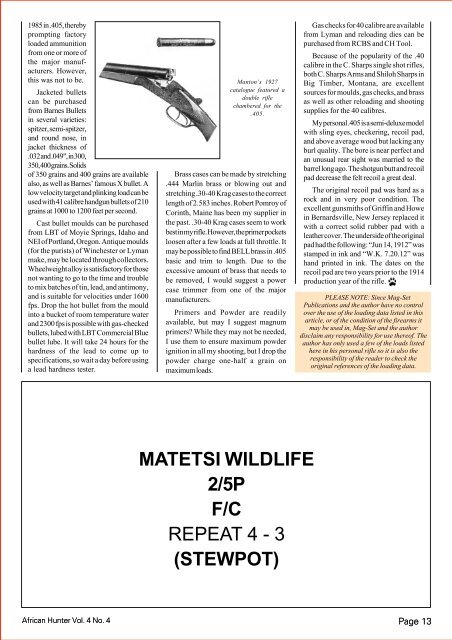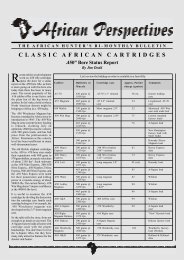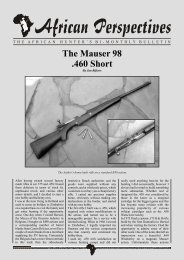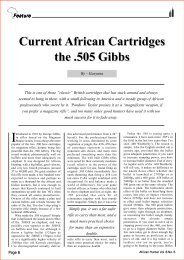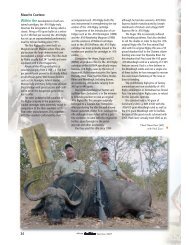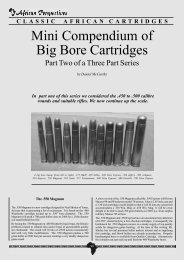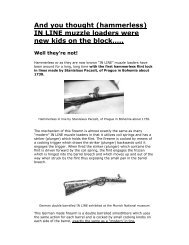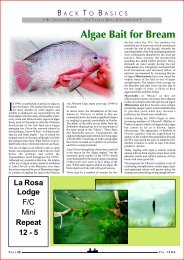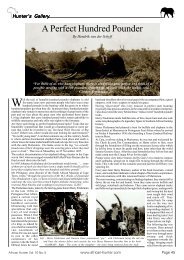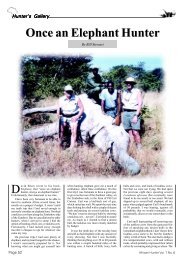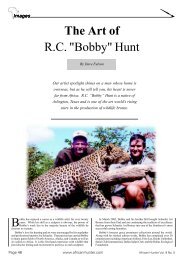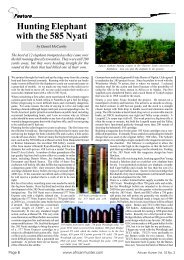America's First African Cartridge Feature - HuntNetwork
America's First African Cartridge Feature - HuntNetwork
America's First African Cartridge Feature - HuntNetwork
You also want an ePaper? Increase the reach of your titles
YUMPU automatically turns print PDFs into web optimized ePapers that Google loves.
1985 in .405, thereby<br />
prompting factory<br />
loaded ammunition<br />
from one or more of<br />
the major manufacturers.<br />
However,<br />
this was not to be.<br />
Jacketed bullets<br />
can be purchased<br />
from Barnes Bullets<br />
in several varieties:<br />
spitzer, semi-spitzer,<br />
and round nose, in<br />
jacket thickness of<br />
.032 and .049", in 300,<br />
350, 400 grains. Solids<br />
of 350 grains and 400 grains are available<br />
also, as well as Barnes’ famous X bullet. A<br />
low velocity target and plinking load can be<br />
used with 41 calibre handgun bullets of 210<br />
grains at 1000 to 1200 feet per second.<br />
Cast bullet moulds can be purchased<br />
from LBT of Moyie Springs, Idaho and<br />
NEI of Portland, Oregon. Antique moulds<br />
(for the purists) of Winchester or Lyman<br />
make, may be located through collectors.<br />
Wheelweight alloy is satisfactory for those<br />
not wanting to go to the time and trouble<br />
to mix batches of tin, lead, and antimony,<br />
and is suitable for velocities under 1600<br />
fps. Drop the hot bullet from the mould<br />
into a bucket of room temperature water<br />
and 2300 fps is possible with gas-checked<br />
bullets, lubed with LBT Commercial Blue<br />
bullet lube. It will take 24 hours for the<br />
hardness of the lead to come up to<br />
specifications, so wait a day before using<br />
a lead hardness tester.<br />
Manton’s 1927<br />
catalogue featured a<br />
double rifle<br />
chambered for the<br />
.405.<br />
Brass cases can be made by stretching<br />
.444 Marlin brass or blowing out and<br />
stretching .30-40 Krag cases to the correct<br />
length of 2.583 inches. Robert Pomroy of<br />
Corinth, Maine has been my supplier in<br />
the past. .30-40 Krag cases seem to work<br />
best in my rifle. However, the primer pockets<br />
loosen after a few loads at full throttle. It<br />
may be possible to find BELL brass in .405<br />
basic and trim to length. Due to the<br />
excessive amount of brass that needs to<br />
be removed, I would suggest a power<br />
case trimmer from one of the major<br />
manufacturers.<br />
Primers and Powder are readily<br />
available, but may I suggest magnum<br />
primers? While they may not be needed,<br />
I use them to ensure maximum powder<br />
ignition in all my shooting, but I drop the<br />
powder charge one-half a grain on<br />
maximum loads.<br />
MATETSI WILDLIFE<br />
2/5P<br />
F/C<br />
REPEAT 4 - 3<br />
(STEWPOT)<br />
Gas checks for 40 calibre are available<br />
from Lyman and reloading dies can be<br />
purchased from RCBS and CH Tool.<br />
Because of the popularity of the .40<br />
calibre in the C. Sharps single shot rifles,<br />
both C. Sharps Arms and Shiloh Sharps in<br />
Big Timber, Montana, are excellent<br />
sources for moulds, gas checks, and brass<br />
as well as other reloading and shooting<br />
supplies for the 40 calibres.<br />
My personal .405 is a semi-deluxe model<br />
with sling eyes, checkering, recoil pad,<br />
and above average wood but lacking any<br />
burl quality. The bore is near perfect and<br />
an unusual rear sight was married to the<br />
barrel long ago. The shotgun butt and recoil<br />
pad decrease the felt recoil a great deal.<br />
The original recoil pad was hard as a<br />
rock and in very poor condition. The<br />
excellent gunsmiths of Griffin and Howe<br />
in Bernardsville, New Jersey replaced it<br />
with a correct solid rubber pad with a<br />
leather cover. The underside of the original<br />
pad had the following: “Jun 14, 1912” was<br />
stamped in ink and “W.K. 7.20.12” was<br />
hand printed in ink. The dates on the<br />
recoil pad are two years prior to the 1914<br />
production year of the rifle.<br />
PLEASE NOTE: Since Mag-Set<br />
Publications and the author have no control<br />
over the use of the loading data listed in this<br />
article, or of the condition of the firearms it<br />
may be used in, Mag-Set and the author<br />
disclaim any responsibility for use thereof. The<br />
author has only used a few of the loads listed<br />
here in his personal rifle so it is also the<br />
responsibility of the reader to check the<br />
original references of the loading data.<br />
<strong>African</strong> Hunter Vol. 4 No. 4 Page 13


